.gif)
Old Stone Fort (Tennessee)
Encyclopedia
The Old Stone Fort is a prehistoric Native American
structure located in Coffee County, Tennessee
, in the Southeastern United States. The structure was most likely built between 80 and 550 AD during the Middle Woodland period
.
The structure is now part of Old Stone Fort State Archaeological Park, one of two archaeological parks in Tennessee (the other being at Pinson Mounds near Jackson
). The site is listed on the National Register of Historic Places
.
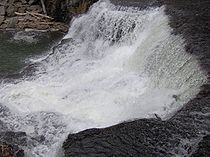 The Old Stone Fort is located on a peninsula created by the confluence of the Duck River
The Old Stone Fort is located on a peninsula created by the confluence of the Duck River
and the Little Duck River
(the section of the Duck River upstream from its confluence with the Little Duck is sometimes called "Barren Fork"). The Duck River forms the peninsula's northwestern boundary, the Little Duck forms the peninsula's southeastern boundary, and a westward bend in the Little Duck forms the peninsula's southern boundary. The walled area of the structure encompasses approximately 50 acres (202,343 m²). (Click for Map)
The Duck River system spills over a limestone-rich shelf of the western Cumberland Plateau
known as the Highland Rim. As the Duck and Little Duck approach their convergence, they rapidly drop in elevation, and have cut relatively deep gorges around the peninsula upon which the ancient structure is located. Both gorges are highlighted by a series of substantial waterfalls and whitewater rapids. The natural waterpower in these two gorges attracted entrepreneurs and millwright
s throughout the 19th century.
The Old Stone Fort is located entirely within Coffee County, and is situated just west of Manchester, Tennessee
. Old Stone Fort State Archaeological Park encompasses 876 acres (3.5 km²) and is managed by the Tennessee Department of Environment and Conservation
.
 The walls of the Old Stone Fort consist of stone and earthwork, and are on average approximately 4–6 feet high. The walls originally consisted of an inner and outer layer of crudely stacked rocks and slabs with gravel and earthen fill in between. Over the centuries, the earthen fill has spilled over the rock layers, giving the walls their current mound-like appearance.
The walls of the Old Stone Fort consist of stone and earthwork, and are on average approximately 4–6 feet high. The walls originally consisted of an inner and outer layer of crudely stacked rocks and slabs with gravel and earthen fill in between. Over the centuries, the earthen fill has spilled over the rock layers, giving the walls their current mound-like appearance.
The walls can be divided into roughly three sections, with two sections running roughly parallel to the Duck and Little Duck Rivers, and a third section running parallel to the southern rim of the peninsula. The sections paralleling the rivers gradually move inward, away from their respective rivers, and approach one another in a pincer-like formation at the northeastern half of the peninsula. Here, both walls terminate just before converging, allowing for a small entrance. Two ancient "pedestal" mounds— one 35 feet (10.7 m) in diameter and the other 48 feet (14.6 m) in diameter— are located on either side of the structure's entrance. The entrance continues through a 120 feet (36.6 m) L-shaped corridor which opens into the structure's interior.
 The fort's northwestern walls (following the Duck River) are approximately 1394 feet (424.9 m) long, and the southeastern walls (following the Little Duck) are approximately 1094 feet (333.5 m) in length. The southern walls, which are basically straight with the exception of an area where the ridge bulges outward, are 2116 feet (645 m) long. Large open sections are found between both the southern wall and the northwestern wall and the southern wall and the southeastern wall. These areas were probably left open due to the fact that they overlook steep bluffs carved out by the Duck and Little Duck rivers whose waters probably performed the same function as the mounds.
The fort's northwestern walls (following the Duck River) are approximately 1394 feet (424.9 m) long, and the southeastern walls (following the Little Duck) are approximately 1094 feet (333.5 m) in length. The southern walls, which are basically straight with the exception of an area where the ridge bulges outward, are 2116 feet (645 m) long. Large open sections are found between both the southern wall and the northwestern wall and the southern wall and the southeastern wall. These areas were probably left open due to the fact that they overlook steep bluffs carved out by the Duck and Little Duck rivers whose waters probably performed the same function as the mounds.
A substantial ditch, known as the "moat", parallels the southern wall at the base of the ridge. This ditch is a natural feature and is actually an abandoned river channel. However, it is not known if this channel was artificially kept open in prehistory.
 By the time Euro-American long hunters and traders arrived in the area in the mid-18th century, a system of well-worn trails traversed the Cumberland Plateau, connecting what is now Middle Tennessee with Georgia and Northern Alabama. One such trail passed near the Old Stone Fort, closely following what is now U.S. Route 41
By the time Euro-American long hunters and traders arrived in the area in the mid-18th century, a system of well-worn trails traversed the Cumberland Plateau, connecting what is now Middle Tennessee with Georgia and Northern Alabama. One such trail passed near the Old Stone Fort, closely following what is now U.S. Route 41
. The ancient structure was no doubt an important landmark to early travelers in the Middle Tennessee area.
The Nickajack Expedition
, led by Major James Ore in the latter part of the Chickamauga Wars
, was believed to have encamped within the Old Stone Fort en route to the Chickamauga towns. The structure also had an important symbolic significance for early Coffee Countians. The county's first court was held at the "Old Stone Fort Tavern" in 1836, and the county seat was laid out upon "Main Stone Fort Creek."
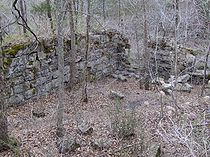 The powerful Duck River made the Old Stone Fort's peninsula an attractive site for mills as early as 1823, when Samuel Murray built a rope factory on the Little Duck River. Although the factory burned in 1847, it was followed by W.S. Whitman's paper mill further downstream in 1852. In 1862, Whitman built a powder factory adjacent to his paper mill to supply the Confederacy
The powerful Duck River made the Old Stone Fort's peninsula an attractive site for mills as early as 1823, when Samuel Murray built a rope factory on the Little Duck River. Although the factory burned in 1847, it was followed by W.S. Whitman's paper mill further downstream in 1852. In 1862, Whitman built a powder factory adjacent to his paper mill to supply the Confederacy
with arms during the Civil War, although the mill was destroyed by Union
troops the following year. In 1879, the Stone Fort Paper Company built a large mill near Big Falls on the Duck River. The mill supplied paper to newspapers throughout the Southeast— including the Nashville Banner and the Atlanta Constitution— until the early 20th century. The mill's foundations are still situated on the bluffs overlooking Big Falls, and can be accessed via the Old Stone Fort Loop Trail.
The property upon which the Old Stone Fort was located eventually passed into the hands of the Chumbley family, who had ties to Stone Fort Paper. The Chumbleys, seeking to protect the Old Stone Fort, passed up numerous private offers for the land upon which the ancient structure was located. In 1966, the State of Tennessee finally purchased 400 acres (1.6 km²) of the Chumbley estate that became the core of Old Stone Fort State Archaeological Park. The Old Stone Fort was added to the National Register of Historic Places in 1973.
 The Old Stone Fort remained a mystery until the University of Tennessee
The Old Stone Fort remained a mystery until the University of Tennessee
conducted excavations within the structure in 1966. Throughout the 19th and early 20th century, numerous theories were put forth regarding the identity of the structure's builders, ranging from the overly-simplistic to the exotic.
In 1823, the Pioneer, a Jackson, Tennessee
newspaper, argued that the Old Stone Fort was built by Buccaneers from Seville after one of their ships wrecked off the coast of Florida and forced them inland. In the mid-20th century, the discoveries at L'Anse aux Meadows
and the supposed recovery of Viking artifacts in various parts of North America led many to believe the Vikings built numerous stone structures throughout the Eastern U.S., including the Old Stone Fort. In 1950, author Zella Armstrong hypothesized that the fort was built by "Welsh-Indian" descendants of Prince Madoc
.
The first serious investigation of the Old Stone Fort was conducted by Joseph Jones at the behest of the Smithsonian Institution
in 1876, uncovering several prehistoric artifacts. He was followed by Tennessee State Archaeologist P.E. Cox's excavations in 1928, which dug several trenches and analyzed the fort's composition.
In 1966, after the purchase of the Old Stone Fort from the Chumbley estate, the State of Tennessee commissioned the University of Tennessee Department of Anthropology to investigate the structure's origins. After digging a series of trenches and test pits and conducting extensive research, the investigators determined the builders of the structure to be Native Americans of the Middle Woodland period. Charles Faulkner, a member of the excavation team, bases this theory on three findings:
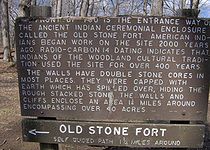
The University of Tennessee investigators also determined that the fort was built gradually over a period of several hundred years, rather than all at once. The builders of the Old Stone Fort are now believed to be two distinct local Middle Woodland cultures known as the McFarland and the Owl Hollow cultures, with the former beginning work on the structure in the 1st century AD and the latter completing it.
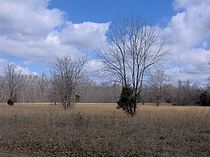 For decades, it was largely assumed (as its name implies) that the Old Stone Fort was used for purposes of military defense. Evidence from the 1966 excavations, however, seem to point more to a religious or ceremonial function, rather than a martial function. Faulkner bases this theory on the following points:
For decades, it was largely assumed (as its name implies) that the Old Stone Fort was used for purposes of military defense. Evidence from the 1966 excavations, however, seem to point more to a religious or ceremonial function, rather than a martial function. Faulkner bases this theory on the following points:
The "moat" that parallels the base of the southwestern edge of the peninsula was originally considered artificial, although 20th-century researchers believe this ditch may be a natural dry riverbed.
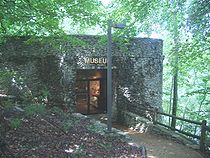
Native Americans in the United States
Native Americans in the United States are the indigenous peoples in North America within the boundaries of the present-day continental United States, parts of Alaska, and the island state of Hawaii. They are composed of numerous, distinct tribes, states, and ethnic groups, many of which survive as...
structure located in Coffee County, Tennessee
Coffee County, Tennessee
Coffee County is a county located in south-central portion of the U.S. state of Tennessee. It is one of the counties of Middle Tennessee. As of 2010, the population was 52,796. Its county seat is Manchester....
, in the Southeastern United States. The structure was most likely built between 80 and 550 AD during the Middle Woodland period
Woodland period
The Woodland period of North American pre-Columbian cultures was from roughly 1000 BCE to 1000 CE in the eastern part of North America. The term "Woodland Period" was introduced in the 1930s as a generic header for prehistoric sites falling between the Archaic hunter-gatherers and the...
.
The structure is now part of Old Stone Fort State Archaeological Park, one of two archaeological parks in Tennessee (the other being at Pinson Mounds near Jackson
Jackson, Tennessee
Jackson is a city in Madison County, Tennessee, United States. The total population was 65,211 at the 2010 census. Jackson is the primary city of the Jackson, Tennessee metropolitan area, which is included in the Jackson-Humboldt, Tennessee Combined Statistical Area...
). The site is listed on the National Register of Historic Places
National Register of Historic Places
The National Register of Historic Places is the United States government's official list of districts, sites, buildings, structures, and objects deemed worthy of preservation...
.
Geographic setting

Duck River (Tennessee)
The Duck River, long, is the longest river located entirely within the U.S. state of Tennessee. Free flowing for most of its length, the Duck River is home to over 50 species of freshwater mussels and 151 species of fish, making it one of the most biologically diverse rivers in North America.The...
and the Little Duck River
Little Duck River
The Little Duck River is a tributary of the Duck River of Tennessee in the United States. Via the Duck, Tennessee, and Ohio rivers, it is part of the Mississippi River watershed...
(the section of the Duck River upstream from its confluence with the Little Duck is sometimes called "Barren Fork"). The Duck River forms the peninsula's northwestern boundary, the Little Duck forms the peninsula's southeastern boundary, and a westward bend in the Little Duck forms the peninsula's southern boundary. The walled area of the structure encompasses approximately 50 acres (202,343 m²). (Click for Map)
The Duck River system spills over a limestone-rich shelf of the western Cumberland Plateau
Cumberland Plateau
The Cumberland Plateau is the southern part of the Appalachian Plateau. It includes much of eastern Kentucky and western West Virginia, part of Tennessee, and a small portion of northern Alabama and northwest Georgia . The terms "Allegheny Plateau" and the "Cumberland Plateau" both refer to the...
known as the Highland Rim. As the Duck and Little Duck approach their convergence, they rapidly drop in elevation, and have cut relatively deep gorges around the peninsula upon which the ancient structure is located. Both gorges are highlighted by a series of substantial waterfalls and whitewater rapids. The natural waterpower in these two gorges attracted entrepreneurs and millwright
Millwright
A millwright is a craftsman or tradesman engaged with the construction and maintenance of machinery.Early millwrights were specialist carpenters who erected machines used in agriculture, food processing and processing lumber and paper...
s throughout the 19th century.
The Old Stone Fort is located entirely within Coffee County, and is situated just west of Manchester, Tennessee
Manchester, Tennessee
Manchester is a city in Coffee County, Tennessee, United States. The population was 10,102 at the 2010 census. It is the county seat of Coffee County...
. Old Stone Fort State Archaeological Park encompasses 876 acres (3.5 km²) and is managed by the Tennessee Department of Environment and Conservation
Tennessee Department of Environment and Conservation
The Tennessee Department of Environment and Conservation is a Cabinet-level agency within the government of the U.S. state of Tennessee, headed by the Tennessee Commissioner of Environment and Conservation....
.
The structure of the Old Stone Fort

The walls can be divided into roughly three sections, with two sections running roughly parallel to the Duck and Little Duck Rivers, and a third section running parallel to the southern rim of the peninsula. The sections paralleling the rivers gradually move inward, away from their respective rivers, and approach one another in a pincer-like formation at the northeastern half of the peninsula. Here, both walls terminate just before converging, allowing for a small entrance. Two ancient "pedestal" mounds— one 35 feet (10.7 m) in diameter and the other 48 feet (14.6 m) in diameter— are located on either side of the structure's entrance. The entrance continues through a 120 feet (36.6 m) L-shaped corridor which opens into the structure's interior.

A substantial ditch, known as the "moat", parallels the southern wall at the base of the ridge. This ditch is a natural feature and is actually an abandoned river channel. However, it is not known if this channel was artificially kept open in prehistory.
The Old Stone Fort in recorded history

U.S. Route 41
U.S. Route 41 is a north–south United States Highway that runs from Miami, Florida to the Upper Peninsula of Michigan. Until 1949, the part in southern Florida, from Naples to Miami, was U.S...
. The ancient structure was no doubt an important landmark to early travelers in the Middle Tennessee area.
The Nickajack Expedition
Nickajack Expedition
Following a peace treaty between Cherokee and white settlers in 1777, during the midst of the American Revolutionary War, followers of the Native American chief Dragging Canoe, all of whom opposed the peace, separated from the tribe and relocated to East Tennessee. They were joined by groups of...
, led by Major James Ore in the latter part of the Chickamauga Wars
Chickamauga wars
The Chickamauga Wars were a series of raids, campaigns, ambushes, minor skirmishes, and several full-scale frontier battles which were a continuation of the Cherokee struggle against encroachment by American frontiersmen from the former British colonies...
, was believed to have encamped within the Old Stone Fort en route to the Chickamauga towns. The structure also had an important symbolic significance for early Coffee Countians. The county's first court was held at the "Old Stone Fort Tavern" in 1836, and the county seat was laid out upon "Main Stone Fort Creek."

Confederate States of America
The Confederate States of America was a government set up from 1861 to 1865 by 11 Southern slave states of the United States of America that had declared their secession from the U.S...
with arms during the Civil War, although the mill was destroyed by Union
Union (American Civil War)
During the American Civil War, the Union was a name used to refer to the federal government of the United States, which was supported by the twenty free states and five border slave states. It was opposed by 11 southern slave states that had declared a secession to join together to form the...
troops the following year. In 1879, the Stone Fort Paper Company built a large mill near Big Falls on the Duck River. The mill supplied paper to newspapers throughout the Southeast— including the Nashville Banner and the Atlanta Constitution— until the early 20th century. The mill's foundations are still situated on the bluffs overlooking Big Falls, and can be accessed via the Old Stone Fort Loop Trail.
The property upon which the Old Stone Fort was located eventually passed into the hands of the Chumbley family, who had ties to Stone Fort Paper. The Chumbleys, seeking to protect the Old Stone Fort, passed up numerous private offers for the land upon which the ancient structure was located. In 1966, the State of Tennessee finally purchased 400 acres (1.6 km²) of the Chumbley estate that became the core of Old Stone Fort State Archaeological Park. The Old Stone Fort was added to the National Register of Historic Places in 1973.
Who built the Old Stone Fort?

University of Tennessee
The University of Tennessee is a public land-grant university headquartered at Knoxville, Tennessee, United States...
conducted excavations within the structure in 1966. Throughout the 19th and early 20th century, numerous theories were put forth regarding the identity of the structure's builders, ranging from the overly-simplistic to the exotic.
In 1823, the Pioneer, a Jackson, Tennessee
Jackson, Tennessee
Jackson is a city in Madison County, Tennessee, United States. The total population was 65,211 at the 2010 census. Jackson is the primary city of the Jackson, Tennessee metropolitan area, which is included in the Jackson-Humboldt, Tennessee Combined Statistical Area...
newspaper, argued that the Old Stone Fort was built by Buccaneers from Seville after one of their ships wrecked off the coast of Florida and forced them inland. In the mid-20th century, the discoveries at L'Anse aux Meadows
L'Anse aux Meadows
L'Anse aux Meadows is an archaeological site on the northernmost tip of the island of Newfoundland in the Canadian province of Newfoundland and Labrador. Discovered in 1960, it is the only known site of a Norse or Viking village in Canada, and in North America outside of Greenland...
and the supposed recovery of Viking artifacts in various parts of North America led many to believe the Vikings built numerous stone structures throughout the Eastern U.S., including the Old Stone Fort. In 1950, author Zella Armstrong hypothesized that the fort was built by "Welsh-Indian" descendants of Prince Madoc
Madoc
Madoc or Madog ab Owain Gwynedd was, according to folklore, a Welsh prince who sailed to America in 1170, over three hundred years before Christopher Columbus's voyage in 1492. According to the story, he was a son of Owain Gwynedd who took to the sea to flee internecine violence at home...
.
The first serious investigation of the Old Stone Fort was conducted by Joseph Jones at the behest of the Smithsonian Institution
Smithsonian Institution
The Smithsonian Institution is an educational and research institute and associated museum complex, administered and funded by the government of the United States and by funds from its endowment, contributions, and profits from its retail operations, concessions, licensing activities, and magazines...
in 1876, uncovering several prehistoric artifacts. He was followed by Tennessee State Archaeologist P.E. Cox's excavations in 1928, which dug several trenches and analyzed the fort's composition.
In 1966, after the purchase of the Old Stone Fort from the Chumbley estate, the State of Tennessee commissioned the University of Tennessee Department of Anthropology to investigate the structure's origins. After digging a series of trenches and test pits and conducting extensive research, the investigators determined the builders of the structure to be Native Americans of the Middle Woodland period. Charles Faulkner, a member of the excavation team, bases this theory on three findings:

- Radiocarbon analysisRadiocarbon datingRadiocarbon dating is a radiometric dating method that uses the naturally occurring radioisotope carbon-14 to estimate the age of carbon-bearing materials up to about 58,000 to 62,000 years. Raw, i.e. uncalibrated, radiocarbon ages are usually reported in radiocarbon years "Before Present" ,...
of charcoal samples found within the structure's walls all dated to approximately 30-430 AD, within the Middle Woodland period.
- The structure's composition, setting, and layout is similar to other structures built by Middle Woodland cultures, such as the HopewellHopewell cultureThe Hopewell tradition is the term used to describe common aspects of the Native American culture that flourished along rivers in the northeastern and midwestern United States from 200 BCE to 500 CE. The Hopewell tradition was not a single culture or society, but a widely dispersed set of related...
people of Ohio and the Pinson MoundPinson Mounds State ParkThe Pinson Mounds comprise a prehistoric Native American complex located in Madison County, Tennessee. The complex, which includes 17 mounds, an earthen geometric enclosure, and numerous habitation areas, was most likely built during the Middle Woodland period . The complex is the largest group of...
builders in West Tennessee.
- Between 1966 and 1971, five Middle Woodland settlements were discovered within 20 miles (32.2 km) of the Old Stone Fort, including a substantial habitation area just 3 miles (4.8 km) downstream.
The University of Tennessee investigators also determined that the fort was built gradually over a period of several hundred years, rather than all at once. The builders of the Old Stone Fort are now believed to be two distinct local Middle Woodland cultures known as the McFarland and the Owl Hollow cultures, with the former beginning work on the structure in the 1st century AD and the latter completing it.
What was the purpose of the Old Stone Fort?

- Defensive structures are typically constructed quickly in response to a perceived threat, whereas the Old Stone Fort was constructed gradually, over a period of several centuries.
- The walls alone are not high enough to have been of defensive value, and no evidence of a palisade has been found.
- The area encompassed by the walls is relatively large and its defense would require a force much larger than the typical Middle Woodland fighting force.
- The 1966 excavations turned up almost no cultural artifacts within the walls, which implies that the enclosure was kept clean, and was probably never continuously inhabited by its builders.
The "moat" that parallels the base of the southwestern edge of the peninsula was originally considered artificial, although 20th-century researchers believe this ditch may be a natural dry riverbed.

The Old Stone Fort Museum
The Old Stone Fort Museum, built by Tennessee State Parks, is located near the park entrance. The museum's exhibits interpret the theories regarding the fort's builders, archaeological excavations at the site, small theater, small welcome/gift shop center, historical lineage of early Native Americans, and the culture of its builders. An observation deck atop the museum displays information about the Old Stone Fort and surrounding rivers and views of the Blue Hole Falls.External links
- Old Stone Fort State Archaeological Park — official site
- Old Stone Fort - TN History for Kids, park description and photos

